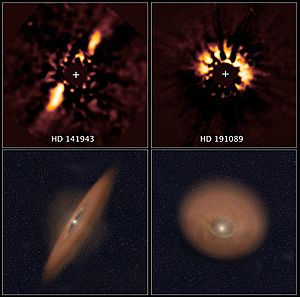Planetesimal facts for kids

Planetesimals are small, solid objects found in the dusty disks around young, forming stars. Think of them as the very first building blocks of planets! They are created when tiny dust particles in these disks bump into each other and stick together.
Contents
How Planets Begin: The Birth of Planetesimals
Planetesimals form in what scientists call a protoplanetary disk. This is a flat, spinning cloud of gas and dust that surrounds a newly born star. Imagine a giant cosmic pancake!
Dust Grains to Pebbles
Inside this disk, countless tiny dust grains, smaller than a speck of glitter, are constantly moving. These grains sometimes gently collide. Because of forces like static electricity, they can stick together, much like dust bunnies form under your bed. Over time, these tiny clumps grow into larger particles, then into pebbles, and eventually into small rocks.
Growing Bigger: The Role of Gravity
As these rocky clumps get bigger, they start to feel the pull of their own gravity. Once a clump reaches about 1 kilometer (about 0.6 miles) in size, its gravity becomes strong enough to attract other nearby rocks and dust. At this point, we call it a planetesimal. This is a big step because gravity helps them grow much faster.
From Planetesimals to Giant Worlds
Once planetesimals form, the process of building planets speeds up.
Collisions and Mergers
Planetesimals continue to collide with each other. When they hit, they often merge, becoming even larger. The biggest planetesimals have the strongest gravity, so they pull in smaller ones more easily. This process is like a snowball rolling downhill, picking up more snow as it goes.
Forming Protoplanets
Over millions of years, these growing planetesimals become even bigger, forming what are called protoplanets. These are like early versions of planets. They are large enough to have a strong gravitational pull, clearing out their paths in the protoplanetary disk.
Building the Solar System
Our own Solar System is thought to have formed this way. The rocky planets like Earth and Mars grew from countless collisions of planetesimals. The cores of the gas giants like Jupiter and Saturn also likely started as large planetesimal cores before gathering huge amounts of gas.
Where Can We Find Planetesimals Today?
While most planetesimals either became part of planets or were ejected from the Solar System, some still exist.
Asteroids and Comets
Many asteroids, especially those in the Asteroid Belt between Mars and Jupiter, are thought to be leftover planetesimals. They never quite managed to join a planet. Similarly, comets, which are icy bodies, are also considered to be icy planetesimals that formed in the colder outer parts of the Solar System.
Kuiper Belt Objects
Beyond Neptune, there's a region called the Kuiper Belt. Objects here, like Pluto, are also considered to be ancient, icy planetesimals that have remained largely unchanged since the early days of our Solar System. Studying them helps scientists understand how planets first formed.
Images for kids
-
486958 Arrokoth, the first pristine planetesimal visited by a spacecraft.
See also
 In Spanish: Planetesimal para niños
In Spanish: Planetesimal para niños


